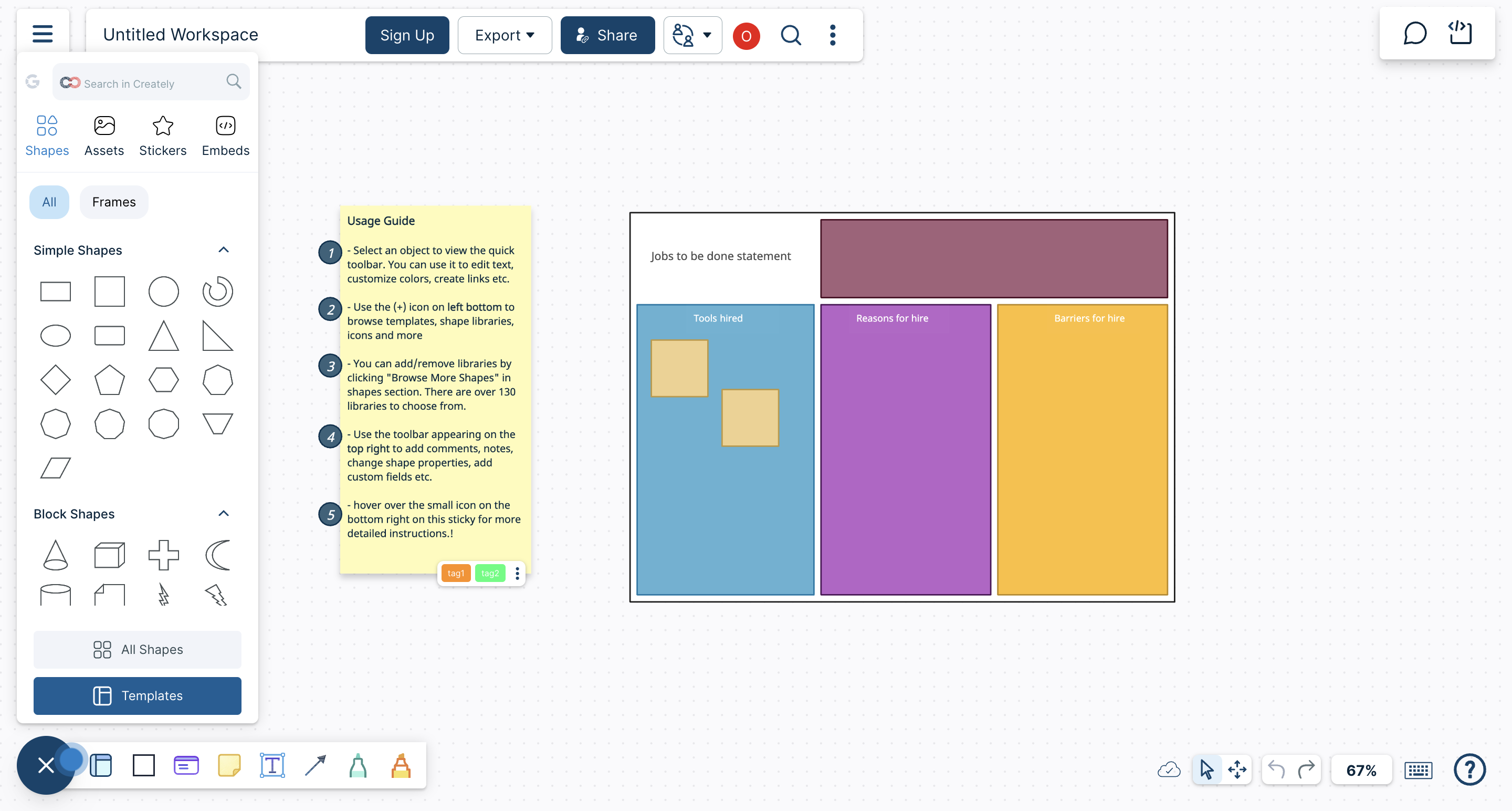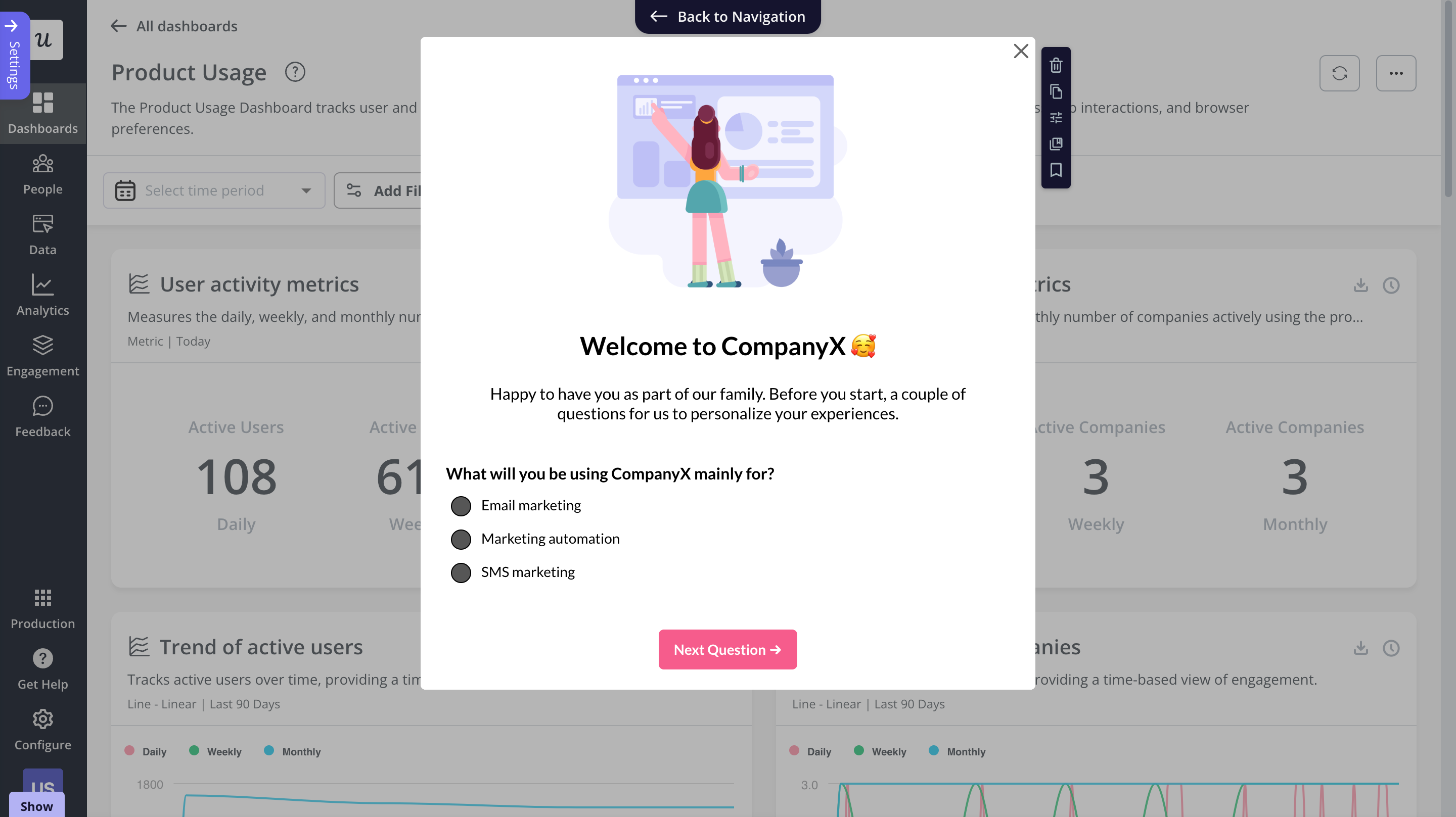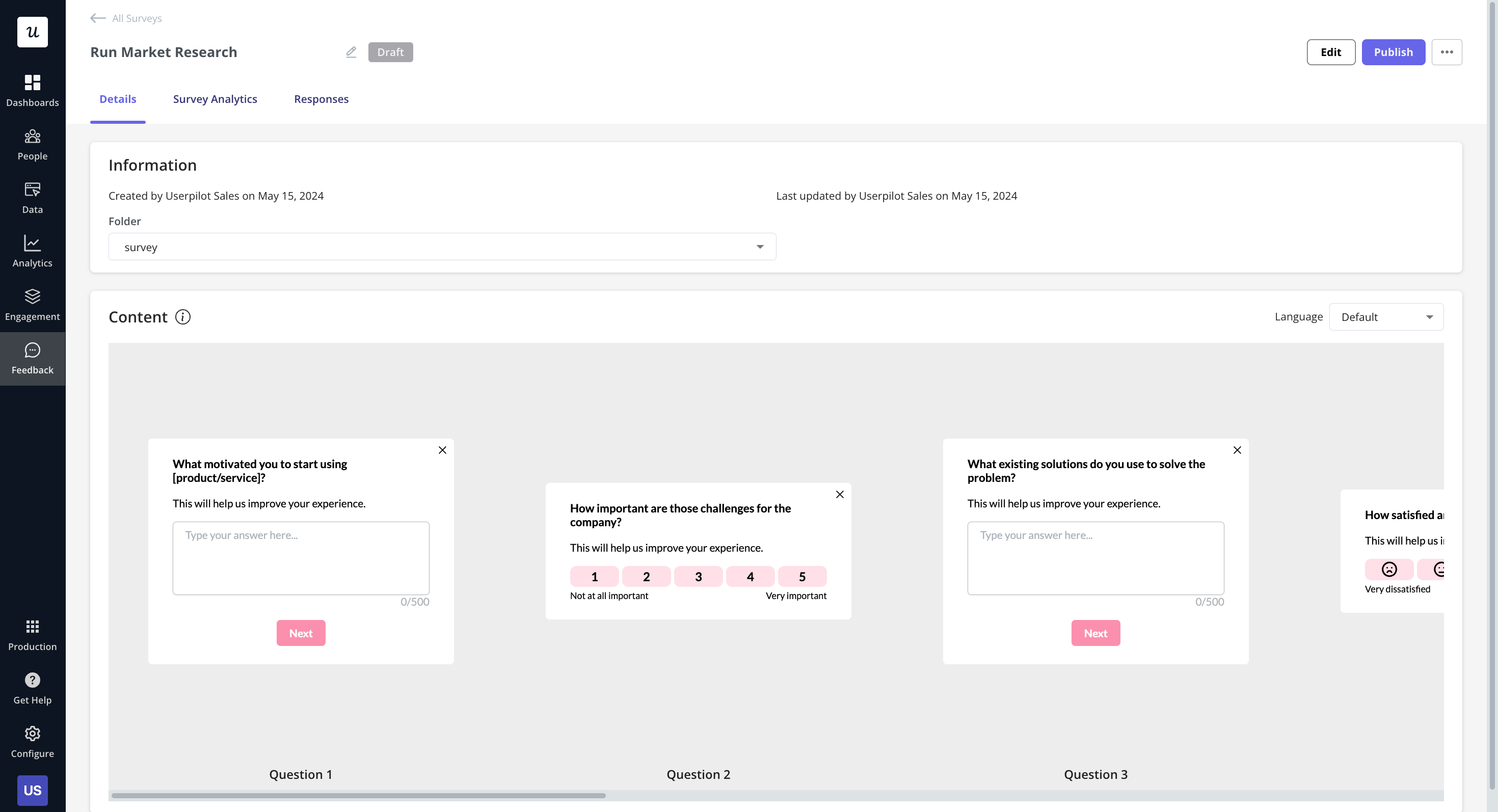
Jobs-to-Be-Done Template: Framework and 7 Examples to Leverage
With a jobs-to-be-done template, you can easily transform your customer interviews into actionable insights and develop an engaging product with high chances of success.
But how can you use it to implement the JTBD theory successfully?
We’ve brought 7 jobs-to-be-done templates that can perfectly lay out your customer JTBDs in an actionable way.
Get The Insights!
The fastest way to learn about Product Growth, Management & Trends.
Jobs-to-be-done template – quick summary
- The Jobs-to-be-done framework is a method for developing products. It operates under the premise that customers purchase products and services to get a “job” done.
- With a jobs-to-be-done template, you can put jobs theory into practice, understand your customer needs easily, ensure that you’re developing a product people will use, and create marketing material that attracts high-quality leads.
- There are seven good JTBD templates you can use, and they come from:
- Miro
- Conceptboard
- Figma
- Creately
- Mural
- Genially
- Freehand
- To pick and use one of these templates, you must collect customer data properly. Here are four methods.
- Use welcome surveys to see what job positions are hiring your product and the tasks they need to get done.
- Conduct customer interviews with regular users and decision-makers.
- Get direct product feedback through in-app surveys.
- Understand the emotional satisfaction of your user base through CSAT surveys.
- Since Userpilot can trigger in-app surveys, why not book a demo to see how it can help you use a JTBD template effectively?
What is the jobs-to-be-done framework?
The jobs-to-be-done framework is a method for developing products. It operates under the premise that customers purchase products and services to get a “job” done.
It helps you capture, define, and categorize all your customer’s needs (jobs that need to get done), and set performance metrics based on your customer’s desired outcome. This way, you can understand what “jobs” make a customer “hire” a product—and then build the perfect product for that job.
Here’s how Tony Ulwick—author of the book “Jobs To Be Done. Theory to Practice” and originator of the term—describes the framework to achieve “outcome-driven innovation”:
“JOBS-TO-BE-DONE is best defined as a perspective — a lens through which you can observe markets, customers, needs, competitors, and customer segments differently, and by doing so, make innovation far more predictable and profitable.”
From a product management perspective, this means you should see your customer needs from the JTBDs lens first to determine what the right solution is. Only then will you build a product that’s likely to achieve product-market fit.
Why should you use a jobs-to-be-done template?
Although Ulwick’s book brings a very solid framework to find JTBDs, it isn’t very specific to your business—especially SaaS businesses.
With a jobs-to-be-done template, you can:
- Put JTBD theory into practice with a predetermined process.
- Get a birds-eye view of why and how customers decide to adopt new products.
- Avoid the risk of developing products or features that no one would use.
- Create marketing material that speaks to your audience’s needs and attracts good-fit customers.
- Have all your customer information and insights in one single document.
So if you’ve decided that the JTBD framework is for you, we highly recommend checking the templates we’re going to cover next.
7 examples of customer jobs-to-be-done framework template
Now, which of the following workable templates should you use?
Let’s take a look:
1. Miro’s JTBD template to understand customer goals
Miro’s template, although far from simple, is very well-organized and straightforward. Allowing you to get a complete picture of your target audience.
To use it effectively, start conducting interviews with newer users. Pay special attention to those who have been using your existing solution for 2 or 3 months or were behind the purchase decision, and then fill in the following sections:
- Demand creation. List the business objectives that your users want to achieve and their corresponding obstacles. Then try to articulate the customer motivations and emotions that are involved when they decide to find a solution to their problems.
- Desired progress. Create multiple job stories about how your ideal customer decided to make a change. Compare the details. Then write the jobs-to-be-done statements (“help me to…” and “so I can…”) that are involved in the story. And finally, determine the signals that make your customers feel like they’re making progress.
- Hiring. List all the possible solutions they hired, fired, and considered for their JTBD. Discuss each aspect of the hiring process. Then use the stickers to determine what parts of these solutions increased or decreased customer trust, their usability, their value for money, and their novelty/familiarity.
You can get access to this template here, but note that you need to sign up for Miro to use it.

2. Conceptboard’s JTBD template to evaluate from a customer’s perspective
This template by Conceptboard is simple, yet it helps you organize the fundamental parts of a proper JTBD framework.
To make the most out of it, take all your customer research data and organize it into these different groups:
- Jobs to be done statements. These statements are framed as an action the customer is trying to perform along with the obstacles they’re facing right now. E.g. “I need to vet job candidates without going over each application manually.”
- Tools hired. List the tools that your market would hire to get the job done. E.g. “Google Docs for documentation.”
- Reasons for hire. Write a list of reasons your customers would hire those tools. E.g. “Integrates with our current tech stack.”
- Barriers to hiring. Brainstorm the reasons why your customers would NOT hire those tools. E.g. “It can’t organize our documents as we’d like.”
The good news is this template doesn’t require you to sign up and you can access it right here.

3. Figma’s JTBD template to identify customer needs
Figma has a fairly simple template that can work pretty well if you don’t have too much data and you need a quick way to upgrade your messaging as part of your marketing strategies.
Here’s how you use this template:
- Identify a JTBD statement from VoC data using the three-sentence template.
- Determine your customer’s goals and their internal motivations to reach those goals.
- Write the challenges preventing customers from achieving those goals.
- List JTBDs based on the previous data.
You can see the template without signing up on this page, but you’d need to create a Figma account if you want to download or edit it.

4. Creately’s JTBD template to capture and organize customer needs
If you’re looking for a straightforward and simple JTBD template, this one from Creately is one to use.
Here’s how you can utilize this template:
- Jobs-to-be-done statement: Describe the core task or goal that the customer is trying to achieve, regardless of the solution used.
- Tools hired: Lists the current products or solutions that the customer uses to get the job done.
- Reasons for hire: Explain the specific motivations or pain points driving the customer to hire (use) these tools.
- Barriers for hire: Highlight the challenges or objections preventing the customer from fully utilizing or adopting the tools.
You can play with this template right away, but to export it, you would need to sign up. Get this template here.

5. Mural’s JTBD template for brainstorming with your team
Mural’s template is great for collaborating and brainstorming with your team. It includes external customer information and context around the user’s position and priorities.
To use it, collect all the customer data you have and host a meeting with your team to brainstorm on the following sections:
- Core functional job. Brainstorm possible tasks with your team and vote on what JTBDs are more accurate. Make sure the JTBDs are solution-agnostic and stable over time.
- Job executor. Map stakeholders involving the job and create a proto-persona of the person performing the tasks.
- Job map. Define the steps and stages of each JTBD based on research.
- Prioritization. Determine what are the customer’s priorities for each JTBD.
You need to sign up to Mural to get access to this template.

6. Genially’s JTBD template to align your products and services
Genially has an interactive template that goes deeper into the customer’s internal triggers and motivators to understand what makes them act and achieve customer satisfaction.
It can look confusing and unclear at first, but this is how you use it:
- The job. The context that triggers the JTBD, the role that performs the task, and the stage of the journey the task is part of.
- Related. State all the customer’s jobs that come before and after it, the bigger job of which the JTBD is part, and the smaller tasks that integrate it.
- Intrinsic, extrinsic, and alternatives. List the activities that the customer is already doing, the outcome they want to achieve, and the current solutions they’re adopting to achieve it.
- Motivation, opposition, and impression. List the needs and desires that push the customer forward, the friction and fears they’re facing, and the “Aha moments” they could experience.
You can see and interact with the template here, but you’d need to sign up to fill in the blanks.

7. Freehand’s JTBD template to capture what customers seek
Freehand has a very simple template if you need a more straightforward process for, let’s say, a copywriting project. It can help you organize the basic JTBD information so you can focus on the essentials.
Here’s all you need to do to use it:
- Brainstorm your customer’s goals and challenges based on your research.
- Determine the JTBDs according to customers’ problems that need to be solved and their related outcomes.
To access this template, however, you need to sign up to InVision from this page.

How to collect jobs-to-be-done data?
As you know by now, using JTBD templates is useless without having the right data at hand.
Doing so would make it a guessing game (bad business approach).
Here are four ways to collect customer data that you can use to follow the JTBD framework:
Use onboarding microsurveys to discover customer needs
With welcome surveys, you can ask new users about their current jobs and what they plan to do with your particular product.
This will help you easily outline the relevant features to their needs, as well as design an onboarding process that leads users to success. But most importantly, you’ll get direct JTDB statements you can add to the templates from earlier—passively.

Conduct customer interviews to capture customer expectations
The most essential method you can’t skip is doing a JTBD interview. As here’s where most of the gold is usually found.
Here’s how you can make sure you’ll get useful insights from customer interviews:
- Identify and interview target customers who need to perform the job.
- Write your questions so they can tell you valuable details about the job. E.G. “What are you trying to find when watching analytics?”
- Ask about every step they need to take to get the job done. You can use the Universal Job Map below (made by Digital Leadership) as a reference.
- Collect valuable quotes that you can use to guide your product development and prioritize features.

Send product feedback surveys to improve your product
Before adopting the JTBD framework to improve your product, it’s important to know what is already working well and what isn’t.
With product feedback surveys, you can see if users are successfully using your product to satisfy their needs. And then, you can decide what features you need to keep, improve, or sunset.
The beautiful part of this is that you can trigger these surveys in-app and collect feedback passively—so you don’t need to distribute it around manually.

Measure product satisfaction to enhance customer experience
Besides understanding how your product fits a specific job, you also need to understand the emotional aspect behind its usage.
Do your users feel like they’re making progress? Do they feel less friction during work?
If you trigger a CSAT survey inside your app, you can collect this information. This way, you can tell what features or what journey stages are providing the most positive or negative feelings in your users (and build a complete JTBD profile).

Conclusion
As said before, using a template can help you put the jobs to be done theory into practice.
Once you’ve collected enough customer data, you can pick one or two templates and start following the JTBD framework to improve product growth.
Since Userpilot can trigger in-app surveys, why not book a demo to see how it can help you use a JTBD template effectively?





